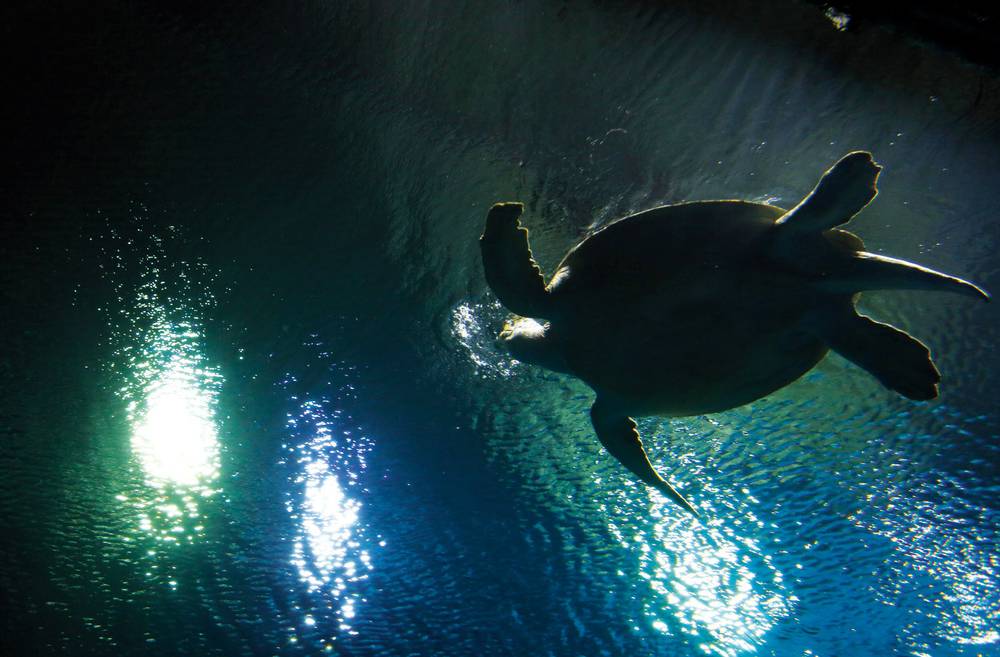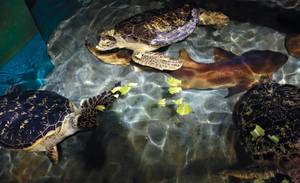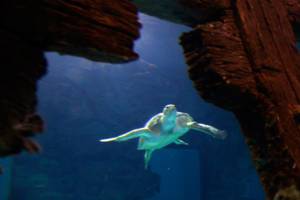OD’s descent from carefree traveler to patient relegated to perpetual captivity started in 1999.
Before that, he lived an adventurous life, hopping eastbound Atlantic currents to feast in the Mediterranean, before cruising back to the Florida Keys for a hot date. He traveled, ate, mingled with ladies. But in 1999, his life changed.
That, coincidentally, was also the year his current home, the Shark Reef Aquarium, opened its doors at Mandalay Bay. Back then, OD wasn’t even OD yet. They called him Pepper.
On July 3, 1999, the Karen Beasley Sea Turtle Rescue and Rehabilitation Center took in a 250-pound green sea turtle near Atlantic Beach, North Carolina.
He was floating at the surface and appeared unable to submerge, a death sentence for sea turtles that need to dive to find the leafy sea greens and other vegetable matter they eat.
The center dubbed the turtle (who listed to one side, indicating air was trapped inside his lungs) Pepper and started him on antibiotics. He suffered from sepsis, a dangerous infection, and pieces of necrotic bone had to be removed from his right side. But as would be the case in future encounters with people, the turtle endeared himself to his caregivers. The center staff nicknamed him the “Shamu of Topsail Beach” because of his “engaging personality.” For more than two years, the center’s biologists nursed him back to health, and in October 2001, he was finally tagged and released back into the Atlantic Ocean.
It would be seven years before researchers saw him again.
Male Atlantic green sea turtles do not mate every year and do not return to shore, unlike females that need to lay eggs. Instead, the males spend most of their long lives—the average lifespan is 80 years—out at sea, and scientists know relatively little about their movements and behavior. They are endangered and, maxing out around 500 pounds, among the largest sea turtles in the world.
They range from New England to Argentina, and can cross the Atlantic to feeding grounds in the Mediterranean and Canary Islands and then swim the 4,000 miles back just as easily to pose for snorkeling tourists in the Caribbean islands.
The next time Pepper had recorded contact with people was in August 2008. He now weighed 283 pounds and, in the heart of his flirtatious 40s, most likely spent the decade after his release in North Carolina procreating with as many females as would have him. At some point, however, his old ailment returned.
On August 15, 2008, a group of divers spotted the sea turtle floating at the surface near French Reef in the Florida Keys, a popular dive spot. His left side poked out of the rolling sea, revealing a foaming, infected wound.
The crew, from the Key Largo tour company Ocean Divers, wrestled the 4-by-3-foot turtle onto their boat.
“They realized he was having problems because he was floating a little bit sideways,” says Joe Angelo, manager of Ocean Divers. “It’s pretty rare for that to happen. For as many turtles as there are out there, we don’t see a lot of injured ones.”
Sick and possibly starving, the turtle wiggled under a bench on the boat deck, hooked his flipper around a leg of the seat and stayed there the entire ride back to the dock.
The divers called the Turtle Hospital in Marathon, Florida, which promptly dispatched an ambulance. Micah Rogers had just started interning at the hospital and was on the two-person rescue team.
“He was huge, the biggest turtle I’d seen to that point,” Rogers recalls. “He had a sore or lesion on his shell, and it was infected and gross. The tissue had been eaten away and it had gotten down to the bone.”
A team of people helped hoist the turtle, now dubbed OD in honor of the boat that rescued him, into the Turtle Hospital ambulance. Rogers rode in the back, at times straddling the massive reptile so he would stay in the ambulance’s kiddie pool and not slam against the vehicle walls.
“Turtles do have personalities, and after he got acclimated to the hospital, OD proved to be a real mellow turtle,” Rogers says. “I had so many fights with other smaller turtles that I would try to treat. They would chase me around the tank trying to bite me. OD was real chill.”
Bette Zirkelbach, current manager of the Turtle Hospital, says OD liked to swim by the sides of his tank so his caretakers could scratch his shell.
The Turtle Hospital spent years diagnosing and treating OD. The lung infection had returned but was now irreparable. Perhaps OD had eaten a piece of garbage floating on the surface, or maybe he suffered internal damage from a boat strike. However the initial injury had occurred, the lung had collapsed and the tissue fused together. The hospital’s biologists fastened weights to the left side of OD’s shell using a marine epoxy, so when the good lung inflated, making one side of OD more buoyant than the other, he could still swim straight.
Like a fingernail, a turtle’s shell is always growing and shedding, and the weights go with it. Because they have to be regularly reapplied, OD can never live in the wild again.
Turtles in captivity with chronic injuries either spend their lives in the Turtle Hospital’s limited space or, if they’re lucky, find an aquarium that offers a refuge. For OD, that “forever home” was Vegas’ Shark Reef Aquarium, home to two other green turtles, both males.
“I’m really happy for him. The Turtle Hospital is great, but if he stayed there the rest of his life, it would be like you or me staying in a hospital for the remainder of our lives because we were paralyzed from the waist down,” Rogers says.
In July, five years after OD was rescued in the Keys, he was flown in a wooden crate from Florida to Las Vegas, with Zirkelbach by his side putting drops in his eyes and keeping his body wet. He spent two months in quarantine inside Mandalay Bay before being gradually introduced into the aquarium’s 1.3 million-gallon tank—a big upgrade from the 100,000-gallon tank at the hospital.
“It’s like Christmas,” says Shark Reef Aquarium Curator Jack Jewell. “Anytime we get a new animal it’s exciting, but people really respond to turtles. We are extremely excited to get him in the exhibit.”
Now weighing a robust 320 pounds, OD languidly cruises around the faux shipwreck and reef at the aquarium. He’s probably around 50 years old and could live to 100. He’s bigger than the other two sea turtles, who, after some “slow motion kung fu” of flipper slaps and nips on the neck, as Jewell describes it, redetermine the hierarchy, much like dogs when they enter a home that already has canines.
OD and the other sea turtles are fed a diet of romaine lettuce, bell peppers and other food separately from the other sea creatures, including the sharks, because they’re so large and strong they will box out the other animals from their food.
Rogers, who cared for OD at the Turtle Hospital, coincidentally took a job working with desert tortoises in Las Vegas this summer and moved here in July. She plans to visit her old friend soon. In November, the team from Ocean Divers plans to visit OD, as well.
The hope is that aquarium visitors will take to OD like his former rescuers did, advancing the cause of conserving sea turtles and all marine life, even in captivity.
“If a turtle is not in the ocean, then the next best thing is if it can go be an advocate for its species, so people can go see them swim and learn about them through education programs that aquariums do,” Rogers says. “They are ambassadors for all those issues sea turtles face.”








